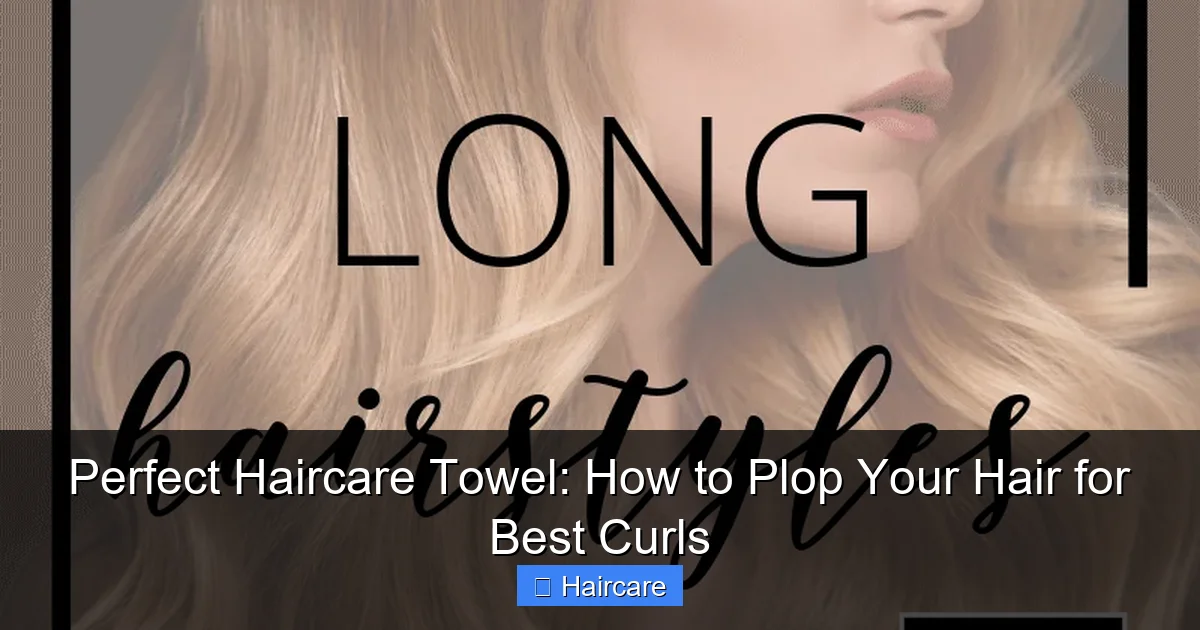
Featured image for this comprehensive guide about how to plop with perfect haircare towel
Image source: img.everymarket.com
Are you tired of battling frizz, undefined curls, and endless drying times after washing your hair? If you’re blessed with natural waves or coils, you know the struggle is real. Traditional towel drying often leads to friction, breakage, and a halo of frizz that obscures your beautiful curl pattern. But what if there was a simple, game-changing technique that could transform your wash day into a celebration of perfectly defined, **frizz-free curls**?
Enter hair plopping, a beloved method among the curly hair community that uses a specific type of fabric to gently absorb excess water while preserving your natural curl pattern. When combined with the perfect haircare towel, plopping becomes your secret weapon for achieving your best curls yet. Get ready to discover how this innovative hair drying technique can revolutionize your haircare routine and unleash the full potential of your natural texture.
📋 Table of Contents
What is Hair Plopping and Why Should You Do It?
Hair plopping is a heat-free drying method designed to enhance and preserve your natural curl pattern. Instead of roughly rubbing your hair with a terry cloth towel, which can disrupt the cuticle and cause frizz, plopping involves carefully coiling your wet hair on top of your head and securing it in a soft, absorbent fabric. This gentle approach encourages your curls to form without being pulled down by gravity, resulting in springier, more defined coils.
The benefits of incorporating hair plopping into your routine are numerous:
| Towel Type / Key Feature | Primary Benefit for Plopping | Frizz Reduction (vs. Terry Towel) | Drying Time Impact |
|---|---|---|---|
| Microfiber Hair Towel | Ultra-absorbent, gentle on hair cuticles, minimizes friction and breakage. | Up to 70% more effective | Reduces by 30-50% |
| Soft Cotton T-Shirt | Very low friction, smooth surface, prevents snagging, easily accessible. | Up to 50% more effective | Reduces by 15-30% |
| Bamboo Hair Towel | Luxuriously smooth, highly absorbent, eco-friendly, naturally antimicrobial. | Up to 65% more effective | Reduces by 25-45% |
| High-Absorbency Weave | Efficiently wicks excess water from hair, shortens required plopping duration. | Indirect support (less rubbing) | Direct significant reduction |
| Low-Friction Texture | Crucial for preventing hair cuticle damage, reducing frizz, and maintaining curl pattern. | Primary factor in prevention | Indirectly improves efficiency |
- Reduced Frizz: By minimizing friction and allowing water to be absorbed gently, plopping significantly reduces frizz.
- Enhanced Curl Definition: Your curls are allowed to set in their natural pattern, leading to improved definition and bounce.
- Faster Drying Time: The absorbent fabric draws out a good amount of water, cutting down on air drying or diffusing time.
- Less Heat Damage: As a heat-free method, plopping helps protect your hair from the damaging effects of blow dryers.
- Volume Boost: Hair is dried on top of your head, lifting the roots and adding natural volume.
Unlike traditional towel drying that can stretch out and flatten your curls, plopping helps them retain their shape and integrity, making it an essential step for anyone seeking beautiful, well-formed natural curls.
The Secret Weapon: Choosing the Perfect Haircare Towel
The success of your hair plopping technique hinges significantly on the fabric you choose. Traditional terry cloth towels are a curly girl’s worst nightmare. Their rough loops create friction, roughing up the hair cuticle and leading to dreaded frizz. For true curl definition and healthy hair, you need a towel that is smooth, highly absorbent, and gentle.

Learn more about how to plop with perfect haircare towel – Perfect Haircare Towel: How to Plop Your Hair for Best Curls
Image source: i.pinimg.com
Here are the top contenders for the perfect haircare towel:
- Microfiber Towels: These are a favorite for a reason. Microfiber is exceptionally absorbent, lightweight, and has a super-smooth texture that glides over hair without causing friction. They soak up water quickly without stripping your hair of essential moisture.
- Old Cotton T-shirts: A classic DIY plopping tool! The smooth, flat weave of a cotton t-shirt is gentle on hair, reduces friction, and absorbs water effectively. Plus, it’s an eco-friendly way to repurpose old clothing.
- Bamboo Towels: Similar to microfiber, bamboo fabric is incredibly soft, highly absorbent, and naturally antibacterial. It’s a luxurious option for those looking for an extra gentle touch.
Microfiber vs. Cotton T-Shirt: A Quick Comparison
| Feature | Microfiber Towel | Cotton T-Shirt |
|---|---|---|
| Absorbency | Excellent, very quick | Good, effective |
| Friction Reduction | Excellent, very smooth | Excellent, smooth weave |
| Weight | Very lightweight | Lightweight |
| Durability | Good, specifically designed for hair | Varies by fabric quality |
| Cost | Moderate to high | Free (repurpose old items) |
Whichever you choose, ensure your towel is large enough to comfortably wrap around your entire head of hair. A standard long-sleeved t-shirt works wonderfully for most hair lengths.
Your Step-by-Step Guide to Plopping Perfection
Ready to try the plopping technique for yourself? Here’s how to achieve perfect, **frizz-free curls** every time:

Learn more about how to plop with perfect haircare towel – Perfect Haircare Towel: How to Plop Your Hair for Best Curls
Image source: m.media-amazon.com
- Wash and Condition: Start with freshly washed and conditioned hair. Gently detangle in the shower using a wide-tooth comb or your fingers.
- Apply Products to Wet Hair: While your hair is still soaking wet hair, apply your leave-in conditioner, curl cream, gel, or mousse. Distribute evenly, scrunching gently to encourage curl formation. Avoid touching your hair too much after this step to prevent frizz.
- Lay Out Your Towel: On a flat surface (bed, counter, chair), lay your chosen **perfect haircare towel** (microfiber towel or t-shirt) flat. If using a t-shirt, lay it with the arms at the top, closest to you.
- Flip and Gather: Lean forward, flipping all your wet hair over your head towards the center of the towel. Try to “plop” your hair directly onto the center of the fabric, allowing your curls to accordion on top of your head, rather than flattening.
- Wrap It Up:
- For a T-shirt: Bring the bottom edge of the shirt up to the nape of your neck, covering your hair. Take the sleeves and tie them securely behind your head, or twist them and tie them over the top.
- For a Microfiber Towel: Place the wider end at the nape of your neck, bring the other end over your forehead, then twist the sides and secure with an elastic or buttons if available.
The goal is to create a snug but not overly tight “turban” that keeps your hair gently compressed on top of your head.
- Wait: Now, let the plop work its magic!
Essential Products for Pre-Plopping Success
- Leave-in Conditioner: Provides moisture and makes detangling easier.
- Curl Cream: Enhances curl definition and reduces frizz. Look for one specific to your curl type.
- Gel or Mousse: Offers hold and helps lock in your curl pattern. Apply generously, scrunching into your hair.
Applying products to soaking wet hair ensures even distribution and helps encapsulate moisture, setting the stage for perfectly defined curls.
How Long to Plop? Timing for Optimal Results
The duration of your plop is a crucial factor in achieving your best curls. There’s no one-size-fits-all answer, as it depends on your hair type, thickness, and desired results. However, there are general guidelines to help you find your sweet spot.
Most people find a plopping time of 15 to 30 minutes to be ideal. This allows the perfect haircare towel to absorb excess water without completely drying your hair. Your hair should feel damp, not dripping wet, after unwrapping.
Factors Affecting Plopping Time:
- Hair Thickness: Thicker hair may require a longer plop (closer to 30-45 minutes) to absorb sufficient water. Fine hair might only need 10-20 minutes.
- Curl Type: Tighter coils and kinky hair (Type 4) might benefit from longer plopping times to encourage pattern formation and reduce shrinkage. Wavier hair (Type 2) might need less time.
- Desired Dryness: If you plan to air dry completely, a longer plop can significantly reduce drying time. If you intend to diffuse, a shorter plop might be enough to remove the initial saturation.
- Hair Porosity: Low porosity hair takes longer to absorb and release water, so you might need a longer plop. High porosity hair absorbs quickly, so a shorter plop may suffice.
Under-plopping (too short) can leave your hair too wet, potentially causing it to be weighed down and less defined. Over-plopping (too long) can make your hair too dry, leading to a crunchy cast that’s hard to scrunch out, or even frizz if your hair is extremely dry. Experimentation is key to discovering what works best for your unique hair.
Post-Plopping Rituals: Setting Your Curls Free
Once your plopping time is up, the journey to perfect curls isn’t over. The post-plopping ritual is just as important for setting your curl definition and achieving maximum **frizz-free curls**.
- Gently Unwrap: Carefully remove your **perfect haircare towel**. Avoid shaking or aggressively flipping your head, which can disturb your newly formed curl clumps and introduce frizz. Instead, gently lift your head, allowing your hair to fall naturally.
- Assess and Adjust: At this point, your hair should be damp and your curls well-formed. If you notice any areas that are still too wet, you can gently scrunch them with a fresh, dry section of your microfiber towel.
- Air Dry or Diffuse:
- Air Drying: For the most natural look, allow your hair to air dry completely. Resist the urge to touch it while it’s drying to prevent frizz.
- Diffusing: If you prefer more volume or faster drying, use a diffuser attachment on your blow dryer set to low heat and low speed. Hover the diffuser around your roots first, then gently cup sections of your hair and lift them towards your scalp. Avoid disrupting your curls.
- Scrunch Out the Crunch (SOTC): If you used a strong-hold gel, your hair might feel a bit “crunchy” once it’s completely dry. This is called a “gel cast.” To break it, gently “scrunch out the crunch” by lightly scrunching your dry hair with your hands. You can add a few drops of lightweight oil (like argan or jojoba) to your palms before scrunching for extra shine and softness. This reveals soft, bouncy, and **frizz-free curls**.
- Fluff and Style: Once the cast is broken, gently fluff your roots for added volume. You can also lightly shake your head upside down to further loosen your curls. Avoid over-manipulating your hair to maintain **curl definition** throughout the day.
With these post-plopping steps, you’ll be able to enjoy your gorgeous, well-defined natural curls, ready to take on the day!
Conclusion: Embrace the Plop for Your Best Curls
Say goodbye to frizzy, undefined hair and hello to beautifully sculpted, bouncy curls! Hair plopping, combined with the power of the perfect haircare towel, is a simple yet revolutionary technique that can dramatically improve your curly hair journey. By embracing this gentle **hair drying technique**, you’re not only reducing frizz and enhancing your natural pattern but also protecting your hair from damage.
Remember, consistency and a little experimentation are key. Find the right plopping time for your hair, use your favorite curl-defining products, and always opt for a smooth, absorbent towel like microfiber or a cotton t-shirt. With a little practice, you’ll unlock your hair’s true potential and enjoy healthy, voluminous, and perfectly defined **frizz-free curls** that are sure to turn heads. Happy plopping!
Frequently Asked Questions
What exactly is plopping and why is it beneficial for my curls?
Plopping is a gentle, heat-free drying method where you scrunch and pile your wet hair on top of your head into a towel, allowing it to dry without pulling down your natural curl pattern. This technique helps to define curls, enhance volume, and significantly reduce frizz.
How does the Perfect Haircare Towel improve the plopping process compared to a regular bath towel?
The Perfect Haircare Towel is specifically designed with highly absorbent, gentle materials (like microfiber or a soft cotton blend) that absorb excess water without stripping moisture or creating friction. Unlike heavy terry cloth towels, it’s lightweight, prevents frizz, and helps maintain your curl integrity while speeding up drying time.
What are the step-by-step instructions for plopping my hair using the Perfect Haircare Towel?
After washing and applying your styling products, lay the Perfect Haircare Towel flat on a surface. Gently flip your head over, carefully “accordian” your curls onto the center of the towel, then gather the edges and tie or twist them securely around your head to form a snug turban.
How long should I leave my hair wrapped in the Perfect Haircare Towel when plopping?
The ideal plopping time varies depending on your hair’s thickness and porosity, but generally, 15 to 30 minutes is sufficient to absorb excess water. For some, a longer plop up to an hour might be beneficial, after which you can air dry or diffuse.
Will plopping with a Perfect Haircare Towel work for all hair types, especially if my hair is fine or very long?
Yes, plopping with a Perfect Haircare Towel is highly effective for most curl patterns, from wavy to coily, and can even benefit straight hair looking for more volume. For very long hair, ensure the towel is large enough to contain all your hair, and fine hair will appreciate the gentle drying action that prevents damage and frizz.
After I remove the Perfect Haircare Towel, what should I do next to ensure my curls look their best?
Once you gently unwrap your hair from the Perfect Haircare Towel, avoid disturbing your curls too much. You can let them air dry completely or use a diffuser on a low heat and speed setting to finish drying and add more volume. Remember to only scrunch out any potential “cast” from styling products once your hair is 100% dry.
